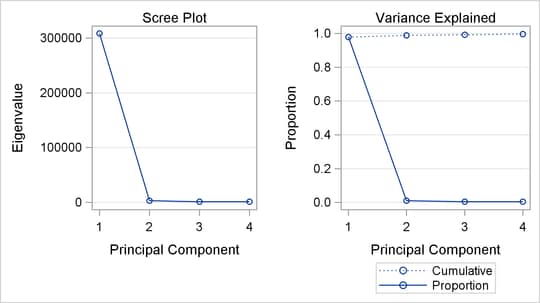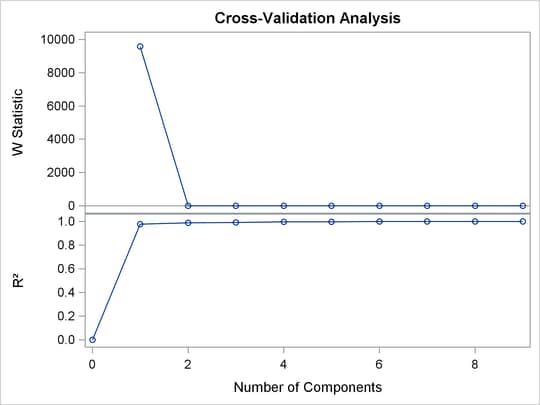The MVPMODEL Procedure
Example 12.1 Using Cross Validation to Select the Number of Principal Components
This example uses cross validation to select the number of principal components in a model. It uses the chromatography data from McReynolds (1970), which is also used in Wold (1978) and Eastment and Krzanowski (1982). The following statements create the chromatography data set:
data mcreynolds; input x1 - x10; datalines; 653 590 627 652 699 690 818 841 654 1006 654 591 628 654 701 691 818 842 655 1006 665 592 624 653 710 690 828 843 659 1014 662 595 629 658 710 692 827 843 660 1012 663 595 630 659 712 693 829 843 663 1013 664 596 629 659 712 692 830 843 663 1015 667 604 635 669 720 700 833 846 668 1016 684 612 642 682 739 702 850 851 682 1035 685 612 642 684 741 703 853 852 685 1039 ... more lines ... 1247 1447 1386 1683 1616 1370 1327 1220 1508 1275 1300 1509 1424 1695 1675 1403 1362 1229 1571 1305 1343 1581 1480 1762 1699 1463 1375 1212 1618 1285 ;
The observations are liquid phases, and the variables are compounds. The ![]() value is the retention index for liquid phase
value is the retention index for liquid phase ![]() in compound
in compound ![]() . The retention index values in the original article had the value of squalane subtracted from them. In this data set, the
values have been corrected by adding the retention indices for squalane to all observations.
. The retention index values in the original article had the value of squalane subtracted from them. In this data set, the
values have been corrected by adding the retention indices for squalane to all observations.
The following statements use the MVPMODEL procedure to select the number of principal components by using one-at-a-time cross validation:
proc mvpmodel data=mcreynolds plots=(scree cvplot) noscale cv=one; run;
The CV= option specifies which method of cross validation to use to produce model diagnostics; in this case one-at-a-time cross validation is used. The PLOTS= option produces only the combination scree plot and variance-explained plot in addition to the cross validation plots.
Output 12.1.1 shows the model and data set information.
Output 12.1.1: Summary of Model and Data Set Information
| Data Set | WORK.MCREYNOLDS |
|---|---|
| Number of Variables | 10 |
| Missing Value Handling | Exclude |
| Number of Observations Read | 226 |
| Number of Observations Used | 225 |
| Maximum Number of Principal Components | 9 |
| Validation Method | Leave-one-out Cross Validation |
Output 12.1.1 shows that one observation, liquid phase 69 (Triton X-400), was omitted because of a missing value. Also, notice that the
maximum number of principal components is ![]() , which is less than the number of variables; this is described in detail in Eastment and Krzanowski (1982).
, which is less than the number of variables; this is described in detail in Eastment and Krzanowski (1982).
The root mean PRESS values and the W statistic are shown in Output 12.1.2.
Output 12.1.2: Residual Summary
| Cross Validation for the Number of Components |
||
|---|---|---|
| Number of Components |
Root Mean PRESS | W |
| 0 | 974.3136 | . |
| 1 | 30.77631 | 9586.179 |
| 2 | 26.85973 | 2.707278 |
| 3 | 26.49878 | 0.211824 |
| 4 | 22.94873 | 2.261922 |
| 5 | 21.50501 | 0.810642 |
| 6 | 20.91568 | 0.279385 |
| 7 | 20.53967 | 0.14514 |
| 8 | 20.25766 | 0.082967 |
| 9 | 20.03932 | 0.04342 |
In this case the index of the last W statistics greater than one is ![]() , suggesting a model with four components as shown in Output 12.1.3.
, suggesting a model with four components as shown in Output 12.1.3.
Output 12.1.3: Cross Validation Results
| Number of Components Suggested by W Statistic | 4 |
|---|
You can also use scree and variance-explained plots to select the number of principal components, as shown in Output 12.1.4.
Output 12.1.4: Scree and Variance-Explained Plots

The plots in Output 12.1.4 indicate that one or two principal components explain almost all the variation.
The W statistic and ![]() plots are shown in Output 12.1.5.
plots are shown in Output 12.1.5.
Output 12.1.5: Cross Validation Analysis

The cross validation plot is produced only when you specify both the CV= option and PLOTS=ALL or PLOTS=CVPLOT.
It is interesting that the cross validation methods of Wold (1978) and Eastment and Krzanowski (1982) choose five and four components, respectively, for this model, whereas a visual examination of the knee in the scree plot might suggest using only one or two components.
